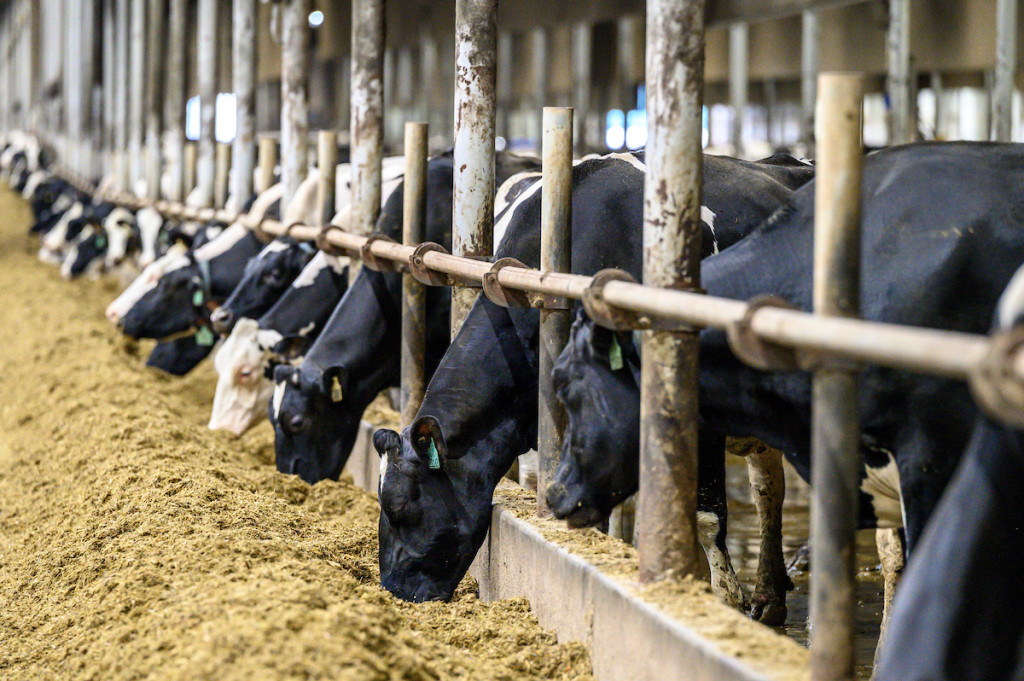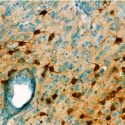Update from UW–Madison experts on bird flu spread

A strain of bird flu virus has spread to dairy herds. Photo: Althea Dotzour
In the last few months, the same strain of bird flu virus that has been circulating since 2022 has spread to dairy herds, with confirmed infections in at least nine states.
As part of efforts to track and minimize the spread of the virus, known as Type A H5N1, the U.S. Department of Agriculture announced a new requirement for testing of lactating cows prior to their transport across state lines. Although genetic fragments of the H5N1 bird flu are being found in the commercial milk supply, pasteurized products are still safe to consume as far as experts can tell.
The virus, which has primarily spread via infected migratory birds, has also infected mammals such as cows, foxes and sea lions. There has also been a report of the virus spreading to a commercial poultry flock on a farm with an infected dairy herd.
Meanwhile, one dairy worker exposed to an infected herd in Texas came down with a mild case of conjunctivitis, but no other H5N1 infections have been reported in humans in the United States as of the end of April 2024.
Researchers are keeping a close eye on the virus and its spread and are analyzing infected raw milk to understand what risks may exist. More research is underway to determine whether the virus is spreading from mammal to mammal, if it spreads through means other than respiratory, and how widespread it is in dairy herds.
Experts at the University of Wisconsin–Madison are assisting these efforts with an eye toward minimizing risk to human health and protecting the state’s agricultural sector.
We touched base with several of those experts to get an idea of what scientists know so far about the developing outbreak, including how the virus may affect dairy products and the industry and what people may need to look out for in themselves, their herds or flocks, and their pets.
Dairy industry and animal health:
Keith Poulsen, director of the Wisconsin Veterinary Diagnostic Laboratory, is one of the scientists working with federal agencies to keep the virus under control while also keeping the needs of dairy farmers and veterinarians on the front lines in mind. He’s been keeping an eye on the disease since 2022 and has been involved with monitoring the recent outbreaks in dairy cows since they first popped up earlier this year.

Keith Poulsen Photo: Bryce Richter
Poulsen says that the USDA’s recent testing requirement is an important measure to mitigate the virus’s spread between states. Current USDA guidance requires that each cow be tested in herds containing 30 animals or fewer, while farmers moving more than 30 animals across state lines only need to test 30 animals. An accredited veterinarian must collect or supervise the sampling.
Normally, at least 50,000 dairy cows cross state lines to move throughout the country each week, Poulsen explains. With the movement of so many cows, the testing requirement could strain farmers, veterinarians and diagnostic labs.
Poulsen explains that there’s a complex web of variables at play that he and his colleagues are navigating and balancing. On one hand, there’s a need to act with caution and implement a conservative approach to minimize further spread of the virus and potential risk to human health. But there are also farmers who rely on the productivity of their herds to make a living and support their families, making reporting infection and dealing with the logistics of testing difficult.
“When you’re managing a multibillion-dollar industry that deals with food and public safety, we want to make sure we’re not giving out bad advice,” Poulsen explains.
He’s also been working with other researchers at UW–Madison to understand what the pasteurization process does to the virus in cow’s milk, and what risks there may be to human health.
Zoonotic disease and human health:
Thomas Friedrich studies how viruses from animals could cross over to humans. While this strain of H5N1 avian influenza is crossing over to mammals, elevating the risk for it to continue to mutate and spread, he says that past bird flu viruses that have infected humans and other mammals have remained “pretty avian,” and not mutated to spread quickly from human to human.

Thomas Friedrich
For the virus to transmit more easily between humans, Friedrich explains it would need to mutate to be able to better attach to mammalian cells. Flu viruses use molecules called receptors to latch onto cells and infect them. The version of the receptor in humans’ upper airways is different from those in birds. That prevents bird flu viruses from infecting cells in humans’ noses and throats, which they would need to do to spread easily from human to human.
Humans do have receptors that bird flu viruses can attach to, but those receptors and susceptible cells are only present deep in the lungs. In previous human bird flu infections, Friedrich says, the virus seemed to only infect those susceptible cells and did not mutate to infect other cells higher up in the respiratory tract that could make it more transmissible to other humans.
The virus would also have to mutate to survive at the temperature of most human respiratory tracts, which tends to be lower than the avian environment in which it currently thrives. So far, Friedrich says the virus appears not to have mutated to be able to better attach to receptors in cows either.
“I think the bottom line is that the danger to the public is currently minimal, but we need to keep an eye on this situation so that we understand how the virus might evolve,” Friedrich explains.

David O’Connor
David O’Connor is an expert in the emergence of new viruses in human populations. He agrees with Friedrich, saying that more data will help scientists keep an eye on the virus’s mutations so potential risks to human health can hopefully be mitigated. O’Connor likened the current human health risk to that of a hurricane far out at sea. No one is entirely sure if the storm will make landfall or not, but it’s best for scientists to continue monitoring and collecting as much data as they can to help everyone prepare, should the storm come.
“There’s the potential for viruses that are at human-animal interfaces to cross species barriers and infect humans, but most of that is simply potential, it’s not actually happening,” O’Connor says. “Unless you are someone who works on a farm in close contact with dairy cows, and unless you’re someone who works on a poultry farm in close contact with poultry, you do not need to worry about getting bird flu.”
Bird flu fragments in milk
Yoshihiro Kawaoka and Peter Halfmann have been studying bird flu for years because of its potential to become a human health concern. As researchers at UW–Madison’s Influenza Research Institute, Kawaoka and Halfmann know a lot about influenza viruses and have the tools to study them safely.
Kawaoka and Halfmann have been consulting with Poulsen to determine what it means that there are fragments of inactive virus in the commercial milk supply.

Peter Halfmann
Halfmann explains that these fragments of virus are simply bits of genetic information, and there is no evidence the milk contains live virus. In fact, generally speaking, most milk likely has fragments of bacterial genetic material that don’t cause reason for concern.
Finding the virus fragments in milk is, however, a possible indication of how widespread the disease may be among dairy herds.
To understand more about virus inactivation, Kawaoka and Halfmann are studying infected raw milk through a process of heat inactivation similar to pasteurization that they’re recreating in the lab.
Having so many researchers at UW–Madison who study various aspects of the dairy industry and the health of herds has proved helpful, as Kawaoka and Halfmann have also teamed up with food science researchers like John Lucey. Lucey helped walk the two through the process of pasteurization so they could understand how to mimic it on a smaller scale in the lab.
Once they receive samples of raw milk infected with the virus, Kawaoka and Halfmann’s team can mimic pasteurization by heating up the samples to different temperatures for various amounts of time. From there they can look at how the virus changes throughout the process.
This work is ongoing, and Kawaoka and Halfmann hope to be able to share their findings as soon as possible to help expand the scientific understanding of this current strain of bird flu.
Pets:
Past strains of the bird flu have been known to infect cats. Erin Lashnits, an expert in zoonotic diseases and their impact on pets and owners, says at this point the risk to our furry friends is likely limited to outdoor cats and those with a known exposure to an infected herd or dead birds.

Erin Lashnits
Clinical signs of infection in cats are nasal discharge, sneezing, coughing, trouble breathing and possible neurological symptoms. However, just because a cat has these signs does not mean they may have avian flu. Regardless, Lashnits says it’s a good idea to seek treatment for a sick cat as it may have something else a vet can treat.
“But if you’re a person that has a cat where you know there could be exposure — either you live nearby one of these herds, or you know that there’s been birds that are affected in your area and you’ve seen dead birds around — then being cautious is probably the right answer,” Lashnits says.
The risk for dogs and indoor cats is even lower than that of outdoor cats. Concerned owners who see signs of respiratory illness in their pets should contact their vets, but the likelihood of bird flu being the cause of infection is very low.
Supply and demand of dairy and poultry products:

Andrew Stevens
Pasteurized and properly cooked food products remain safe for consumption, but that doesn’t mean there won’t be an impact on the dairy and poultry economy.
Andrew Stevens, who studies the effects of agricultural and food policies on consumer food supply and demand, says there are likely two pathways the current virus could impact food availability and prices.
“The first pathway is through actual disruptions to supply. The other is through consumer perception of risk,” Stevens says.
Infected cows experience lower milk production, and infected flocks often have to be culled, thereby lowering the amount of product available to consumers. The other side of the coin is that even if consumers are assured products are safe, the association with infection may be enough to turn them away from purchasing those products. Stevens is monitoring the virus and its potential effects on consumers and producers moving forward.
Tags: health & medicine



